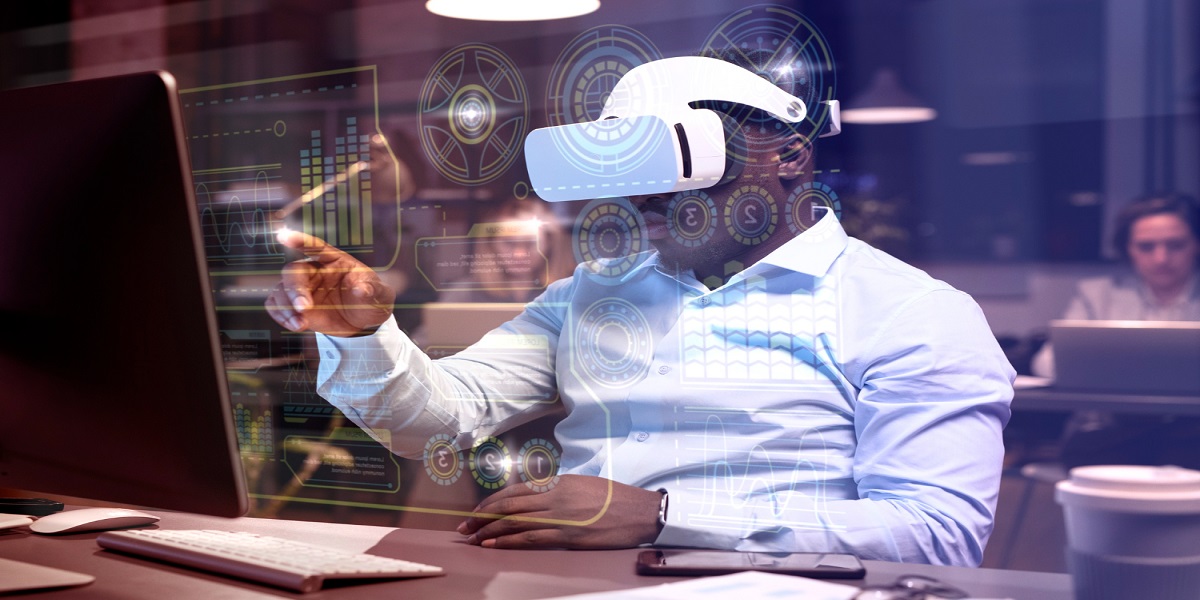In an age where technological advancement knows no bounds, the worlds of AR and VR have emerged as pioneers captivating both tech aficionados and industries worldwide. These innovative technologies are reshaping the boundaries of human experience redefining how we perceive and interact with the digital and physical realms. In this comprehensive exploration we embark on a journey into the captivating domains of AR and VR unraveling their diverse applications discerning the nuances that set them apart and envisioning the boundless potential they hold for our digital future.
Understanding AR and VR
At the heart of this technological revolution lie the concepts of AR and VR. AR enriches our perception of reality by seamlessly blending digital elements into our physical environment. It overlays virtual information onto the real world enhancing our interactions and experiences. On the other hand virtual reality transports us to entirely digital realms offering immersive and all-encompassing environments that engage multiple senses enabling us to explore new dimensions and scenarios.
The key components of both AR and VR technologies encompass advanced sensors, precise tracking systems, robust processing units, and immersive display technologies. These elements work in harmony to create seamless, interactive, and immersive experiences that blur the lines between the physical and digital worlds.
Applications of Augmented Reality:
Real-World Use Cases
AR in Retail and E-Commerce:
The retail landscape has undergone a profound transformation with the integration of augmented reality. Shoppers can now leverage their smartphones and AR applications to visualize products within their personal environments before making purchasing decisions. This innovative approach revolutionizes the shopping experience, allowing customers to virtually try on clothes, experiment with furniture placements, and more, enhancing user confidence and reducing return rates.
AR in Education and Training:
In the realm of education and training, augmented reality is a game-changer. Educational institutions and corporations are harnessing AR to create immersive and interactive learning experiences. Students can delve into intricate subjects through interactive 3D models, while professionals engage in lifelike training simulations to refine their skills. Whether dissecting virtual frogs or practicing complex surgical procedures, AR is transforming how knowledge is acquired and applied.
AR in Healthcare and Medicine:
In the realm of healthcare, augmented reality is empowering medical professionals with innovative tools. Surgeons can access crucial patient data, such as medical images and diagnostic information, overlaid directly onto their field of view during procedures. This augmentation enhances precision, reduces the risk of errors, and ultimately improves patient outcomes.
AR in Architecture and Design:
Architects and designers are leveraging augmented reality to reshape their creative processes. Clients can now experience architectural designs in an entirely new way, walking through virtual representations of their future homes and structures. This immersive visualization streamlines communication, fosters better understanding, and expedites decision-making in the design and construction phases.
Entertainment and Gaming:
AR Games and Experiences:
The gaming industry has embraced augmented reality, giving birth to captivating experiences that merge the virtual and real worlds. Games like Pokémon GO have taken players on real-world adventures, where digital characters and objects are seamlessly integrated into physical environments. This interaction encourages outdoor exploration and fosters community engagement.
AR in Live Events and Sports:
Augmented reality has breathed new life into live events and sports broadcasts. Audiences can now access real-time statistics, player profiles, and interactive visualizations that enhance their viewing experience. From interactive stadium experiences to data-rich overlays during sports matches, AR adds a dynamic layer to live entertainment.
Applications of Virtual Reality:
Immersive Virtual Environments:
Virtual reality ushers us into entirely new dimensions, creating immersive worlds that captivate our senses. In the realm of entertainment VR has become a cornerstone offering gamers the chance to embark on breathtaking journeys, engage in heart pounding adventures and connect with fellow players in astonishingly lifelike environments.
VR in Training and Simulation:
Industries requiring intricate training scenarios are embracing virtual reality as a transformative tool. Pilots, for instance, can refine their skills in virtual cockpits that mimic real flight conditions, while medical professionals practice complex procedures within a risk-free virtual realm. This immersive training accelerates skill development and enhances proficiency.
VR in Healthcare and Therapy:
Virtual reality's impact on healthcare and therapy is profound. Patients grappling with chronic pain can find relief through distraction therapy, where immersive experiences divert their attention from discomfort. Additionally, VR serves as a powerful tool in exposure therapy, aiding individuals in confronting phobias and overcoming traumatic experiences.
VR in Architecture and Real Estate:
The integration of virtual reality is revolutionizing architectural visualization and real estate marketing. Prospective buyers can embark on immersive virtual tours of properties, experiencing the look and feel of potential homes before physically visiting them. This application transcends geographical barriers, allowing clients to explore properties regardless of their location.
VR in Education and Learning:
Education is undergoing a metamorphosis with the integration of virtual reality. Students can transport themselves to historical epochs, plunge into the depths of the ocean, or journey through the cosmos—all from the confines of their classrooms. VR fosters experiential learning, making educational content engaging and unforgettable.
Differences between Augmented Reality and Virtual Reality:
While both augmented reality and virtual reality share the common goal of enhancing human experience through technology, they diverge significantly in their approach and impact.
User Experience and Interaction:
Augmented reality seamlessly integrates digital elements into the real world, offering users an enhanced and enriched view of their surroundings. It supplements our sensory perception with valuable information, often through devices like smartphones or smart glasses. In contrast, virtual reality immerses users entirely in digital environments, temporarily disconnecting them from the physical world. VR headsets create a fully encompassing experience, isolating users from their surroundings and transporting them to immersive alternate realities.
Real-World Integration:
Augmented reality thrives on real-world integration, enhancing our immediate surroundings with digital overlays. This integration yields applications across diverse sectors, from retail and healthcare to education and entertainment. On the other hand, virtual reality operates within self-contained virtual realms, constructing entirely new experiences that may be unrelated to the physical environment. VR is a gateway to imaginative worlds, where users can explore fantastical landscapes or relive historical moments, unbound by the constraints of reality.
Hardware Requirements:
One of the significant differentiators between AR and VR lies in their hardware requirements. Augmented reality often leverages devices we already possess, such as smartphones or tablets, equipped with cameras and sensors to capture and overlay digital content onto the physical world. This accessibility has facilitated the rapid adoption of AR technology. In contrast, virtual reality necessitates dedicated hardware, primarily VR headsets. These headsets encompass high-resolution displays, intricate motion tracking systems, and sometimes even hand and body tracking, enabling users to be fully immersed in digitally rendered environments.
Complementary and Converging Technologies:
As technology continues its relentless march forward the convergence of augmented reality and virtual reality has birthed a new frontier Mixed Reality. Mixed reality represents an exciting fusion of both AR and VR, seamlessly integrating digital content with the physical world in real time. MR devices, exemplified by Microsoft's HoloLens allow users to interact with virtual objects while maintaining a tangible connection to their surroundings.
Mixed reality extends the possibilities even further, enabling users to manipulate, interact with, and reshape digital elements within their real-world context. This convergence unlocks a realm of innovative applications, from immersive architectural visualizations that meld virtual designs with physical spaces to engaging educational experiences where digital content seamlessly coexists with real-world objects.
Future Potential and Trends:
The Evolution of AR and VR Devices:
The trajectory of AR and VR is poised for substantial advancements in hardware. Manufacturers are focused on creating lighter, more comfortable, and aesthetically appealing headsets. Improved processing capabilities and enhanced graphics will contribute to more immersive experiences. The ultimate vision is to seamlessly integrate AR and VR into wearable devices, such as smart glasses, that provide users with real-time information and interactions overlaying their physical environment.
Advances in Content Creation and Interactivity:
The future of AR and VR is intrinsically tied to content creation. Innovations in software and tools will empower creators to fashion intricate and immersive experiences that captivate users. The marriage of interactive storytelling, educational simulations, and lifelike training scenarios will characterize the next wave of AR and VR applications. As content becomes increasingly sophisticated, users can anticipate heightened engagement and novel ways to learn, work, and play.
AR and VR in Social Interaction:
The integration of AR and VR into social platforms holds the potential to redefine human connection. Virtual meetings, digital hangouts and shared immersive experiences will bridge geographical distances enabling individuals to interact and communicate as if they were physically present. These technologies will catalyze a paradigm shift in how we forge connections, collaborate, and engage in shared experiences, transcending the limitations of time and space.
Integration with AI and Machine Learning:
As AR and VR continue to mature their integration with artificial intelligence and machine learning will become increasingly prevalent. Smart algorithms will analyze user behavior, preferences, and contextual data to deliver personalized and contextually relevant experiences. This synergy will amplify the impact of AR and VR, enhancing user engagement and utility across a myriad of applications.
Challenges and Considerations:
Technical Challenges:
While the potential of AR and VR is immense, they still face technical hurdles. Improving display resolution, reducing latency, and enhancing tracking accuracy are ongoing challenges in delivering seamless and immersive experiences. Additionally, as devices become more compact and sophisticated, managing heat dissipation and power consumption becomes crucial for user comfort and extended usage.
Ethical and Privacy Concerns:
The integration of AR and VR into daily life raises ethical and privacy concerns. As these technologies intertwine with our real-world interactions questions about data privacy surveillance and user consent arise. Striking a balance between the benefits of immersive experiences and safeguarding personal information will be a critical consideration.
User Acceptance and Adoption:
For AR and VR to reach their full potential, user acceptance and adoption are paramount. While technology enthusiasts and early adopters embrace these technologies, the broader public may require further education and compelling use cases to fully embrace AR and VR. Providing seamless, intuitive, and valuable experiences will be instrumental in driving widespread adoption.
Conclusion:
As we navigate the dynamic landscape of AR and VR we witness the convergence of innovation imagination and technology. These immersive technologies have transcended the realm of science fiction embedding themselves into our everyday lives and reshaping the way we interact with our environment. Augmented reality enriches reality, while virtual reality crafts new ones, each offering unique dimensions of experience.
The journey ahead is marked by untold potential and limitless creativity. As hardware evolves content becomes more captivating and user experiences become increasingly seamless the boundaries between the real and the virtual will continue to blur. AR and VR are propelling us toward a future where the possibilities are bounded only by our imagination. As we step into this transformative era let us embrace the convergence of the physical and the digital for it is within this synergy that the true magic of technology resides.

